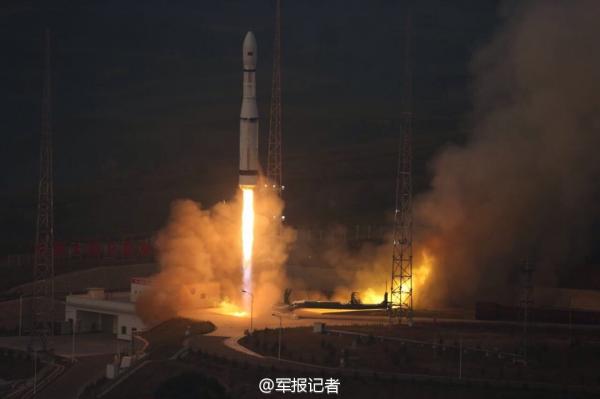![[IMG]](http://www.dingsheng.com/data/attachment/forum/201509/20/123626zfcffmf9a9gzilzp.jpg)
![[IMG]](http://www.b14643.de/Spacerockets_1/China/CZ-NGLV/Gallery/YF-100_1.jpg)
![[IMG]](http://www.b14643.de/Spacerockets/Diverse/Asian_Rocket_engines/YF-115.jpg)
![[IMG]](http://www.b14643.de/Spacerockets_1/China/CZ-NGLV/Gallery/YF-100_2.jpg)
CZ 9
CZ-6 (Long March 6) has successfully launched!
![[IMG]](http://cdn3.gbtimes.com/cdn/farfuture/HivE94-Xb2JvEegJ5eT96ZtmGzbUvF1I6gIIFSa3JqI/mtime:1442705610/sites/default/files/styles/768_wide/public/2015/09/20/cz-6-1st-launch-20-09-2015-cctv-cgi.jpg?itok=P75dibnG) A CGI image of the Long March 6 - the first next generation launch vehicles - blasting off. (Photo: Framegrab/CCTV)
A CGI image of the Long March 6 - the first next generation launch vehicles - blasting off. (Photo: Framegrab/CCTV)Successfully launched the first Long March 6 carrier rocket on Sunday morning, the first of a new generation of rocket families designed to boost the country’s space capabilities, including constructing a space station and future lunar missions.
The Long March 6 blasted off from the Taiyuan Satellite Launch Centre in the northern province of Shanxi at 0700 Beijing time (2300 UTC, September 19), sending a payload of 20 small satellites into Sun synchronous orbit.
The satellites, developed by a number of universities and space research institutes across China, include nine amateur radio satellites. The satellites separated from the rocket 15 minutes after blasting off from Taiyuan.
With Chinese authorities and media remaining quiet, online posts from those involved with amateur radio satellites offered the first indications that the launch was successful.
The liquid-fuelled Long March 6 was developed by the Shanghai Academy of Spaceflight Technology, and designed to be a more adaptable, reliable and responsive launch vehicle. Notably, it greatly increases China’s rapid response launch capabilities.
While the Long March 6 has only a modest lift capability of 1,080 kg, the launch was the crucial first full flight test of the new YF-100 engine, which is required to make China's ambitious space plans possible.
The YF-100 will power the Long March 5, China’s new heavy-lift launch vehicle which is roughly comparable in lift capability to the US Delta-IV Heavy. The Long March 5 is set to make its debut flight early next year.
A problem with the Long March 6 first stage engines would thus have been a serious blow to China’s space program and could have brought significant delays.
The first attempt at the launch, 24 hours earlier on Saturday morning, was reportedly scrubbed ten minutes before lift-off for technical reasons.
![[IMG]](http://cdn3.gbtimes.com/cdn/farfuture/8i_Qk_rdUnT0ulBYXohuJAI35AmSSFav9qlhdgNV5mg/mtime:1442705202/sites/default/files/inline_images/cz-6-1st-launch-3rd-stage-20-09-2015-cctv.jpg)
Space station and Moon mission plans
The Long March 5 is crucial to China’s future space ambitions, boosting lift capacity by around three times and will thus be relied upon to launch modules for the country’s upcoming space station, as well as a lunar sample return mission set for 2017.
Joan Johnson-Freese, Professor of National Security Affairs at the US Naval War College, expressed her personal view to gbtimes ahead of Sunday's launch that the Long March 5 that will signal a leap forward in Chinese capabilities.
“China’s three step human spaceflight program, Shenzhou, relies on the Long March 5 to lift its large space station to orbit, and in order to do a human lunar mission - anticipated as their “next step” - the Long March 5 is needed as well,” Johnson-Freese explains.
Professor Huang Jun at the Beijing University of Aeronautics and Astronautics told gbtimes that the new rockets mark a technological breakthrough for the country:
“This new generation of Chinese launch vehicle series uses universal modularized design which can be easily combined into new rocket variants for various missions. The reliability and launch preparation time are improved and the launching cost will be lowered.”
Huang also notes that the incendiary agents used for the new rockets are kerosene and liquid hydrogen, which are considered non-toxic, low or non-polluting when compared with the highly toxic unsymmetrical dimethyl hydrazine (UDMH) used in the currently used Long March 2, 3 and 4 series.
'Expanding capabilities'
The Long March 5, 6 and 7 rocket families are expected to provide increased reliability and adaptability, as well as lower launch costs and shorter preparation time. As the rockets mature over the next decade, they will replace their hydrazine-fuelled predecessors.
As well as developing new rockets, China has constructed a brand new launch base on the southern island province of Hainan.
The Wenchang Satellite Launch Centre, from which launches will take advantage of the Earth’s greater rotational speed at lower latitudes, took six years to construct and cost an estimated five billion yuan (US$800 million) and is another crucial component in China’s plans.
Wenchang has dedicated launch towers for the Long March 5 and the medium-lift Long March 7, both of which will be used for constructing and servicing the upcoming space station, and any interplanetary missions.
“What this means for the US and all space faring nations is another indicator that China is a long-term player in space with expanding capabilities. It cannot be denied or ignored, as the US has tended to do,” Johnson-Freese states.
ANDREW JONES | China launches first of its next generation rockets | gbtimes.com
Deflecting the flames of a monster rocket | The Planetary Society
CZ-6 has successfully launched
20 satelite onboard CZ-6




![[IMG]](http://img.meyet.com/forum/201509/20/124139ufcgicfcg0g03h0l.jpg)
![[IMG]](http://img.meyet.com/forum/201509/20/124200ry3wxa7tqg7g9t3t.jpg)
![[IMG]](http://img.meyet.com/forum/201509/20/124217yqivqknn7yih55t1.jpg)
![[IMG]](http://img.meyet.com/forum/201509/20/124210ma5hvppeok8vnk8z.jpg)
Post a Comment Blogger Facebook Disqus